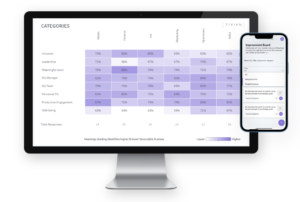In this employee engagement vs employee experience article, we look at the key differences, the fundamentals of the concepts and why they’re so important for HR teams to master.
Why the power is now in the hands of the employee
With increasingly more individuals opting for a gig-based freelance career – and others free to explore a wider job market thanks to more remote positions – the power is in the hands of the employee. Many can afford to choose where they work, and who they work with.
The pressure is on organisations to not only hire well but retain their existing talent. Job satisfaction is, however, a metric prone to fluctuation. So visibility, technology and consistency will be key in delivering a more satisfying and fulfilling employee experience.
Employee engagement and experience are two separate entities but they function best when working in unison. In this post, we’ll outline the differences between the two (employee engagement vs employee experience) so you can foster greater strategies and impact in both areas, delivering a more cohesive and positive environment.
Employee engagement vs employee experience: The key differences
First, let’s start with the key differences between employee engagement and employee experience.
Engage for Success defines employee engagement as “a workplace approach resulting in the right conditions for all members of an organisation to give their best each day, committed to their organisation’s goals and values, motivated to contribute to organisational success, with an enhanced sense of their own well-being.” At Tivian, we relate engagement to how people think, feel and act at work. Those who show rational and emotional commitment to their employer, and act in the best interests of their employer, expending discretionary effort, are engaged.
Employee experience, on the other hand, at its simplest level is about what it’s like to work somewhere – from the first day onwards, and across every touchpoint and interaction. But some industry experts go further. For example, Josh Bersin describes it as “a company-wide initiative to help employees stay productive, healthy, engaged and on track”. This makes EX much more than HR’s responsibility. All parts of the company have a role in creating a great employee experience, from Finance, IT and facilities to corporate social responsibility (CSR) and communications.
The success of your employee engagement and experience depends on listening to your staff and implementing informed strategies as a result of honest feedback and real-time insights.
The fundamentals of employee engagement

Employee engagement is a two-way relationship between an employee and the organisation – which is arguably more complicated given the current climate.
Those who show a commitment to their employer and act in the organisation’s best interests are considered to be engaged. Employee engagement has also been closely linked to higher levels of employee wellbeing and performance.
Some of the fundamental contributors to successful employee engagement include shared values, tailored benefits, recognition, a clear path for development and good relationships. 67% of employees say they stay at a job because of their good relationships with co-workers, which is perhaps what makes it such a weighting factor in engagement. Being connected to your peers and feeling like an active contributor within a team can have great socio-economic benefits that impact overall wellbeing.
Development is also a great determiner. Research has revealed that 44% of employees feel that their company doesn’t value their development, as without a clear path of development or career progression, employees become disengaged and unmotivated. Access to meaningful training and learning, praise and recognition, and regular communication are fundamental to promoting better engagement.
The fundamentals of employee experience
The elements of a great employee experience are similar to those that drive engagement. What’s vital is that they are delivered consistently, across the employee journey, and that they cover an employee’s whole working life.
A good employee experience is now one of the most important things an organisation can provide to support their staff. And we don’t mean just money, ping pong tables and pizza Fridays! A positive environment where workers feel empowered to innovate, develop, express their true identities and engage in work that makes them feel fulfilled and purposeful is closer to the ideal view of today’s coveted workplace experience.
Employees want to feel a part of a company’s future growth and success. But this is becoming harder in a landscape of remote and hybrid teams. To create a great employee experience, you need tools that encourage open feedback, so you can listen to your employees and capture meaningful data and trends surrounding their preferences.
Employee engagement and employee experience: how one feeds into the other
The employee experience is centred around the employee lifecycle. From the moment a job opening is listed, potential employees begin the experience with your company. A positive employee experience is dependent on employee engagement. The best way for business leaders to redefine their employee experience is through real-time employee engagement insights, provided by current employees, which can in turn inform their organisation’s employee experience strategy moving forward.
The intrinsic link between employee engagement and employee experience is clear. But today’s employers today are faced with new challenges. Maintaining engagement across remote, hybrid and in-house teams requires new levels of visibility and a greater focus on communication. If teams are physically based on different localities, it’s more likely they’ll become disconnected from the shared values and direction of the company. Blindspots can appear and it becomes difficult to see who needs improvement, nurturing, or who is becoming disengaged before it’s too late.
Why organisations must improve employee experience now more than ever
The cycle of re-hiring, re-training and grappling with employee retention strategies is becoming one of the greatest pressures on modern businesses. We can’t survive without our workforce, but we’ll struggle to thrive without an engaged and motivated workforce.
Employees are becoming more selective about where they work and who they choose to work with. There’s more flexibility and opportunities to leave and go elsewhere, and rival companies are ready to poach your best talent.
High-performing employees who are motivated, engaged and perform well are the key to bringing organisations closer to reaching their goals. When employees are fulfilled they’re more likely to deliver improvement, innovate and connect with the company culture. The business benefits are endless.
How companies can use employee experience tools to support their efforts

Employee happiness is central to engagement and retention and delivering a positive experience. The employer-employee relationship is potentially in turmoil, but companies that opt for greater insights and visibility can consciously invest in creating insight-driven experiences that place emphasis on employee wellbeing, development and co-working relationships.
The answer is technology. There are various employee experience tools and software solutions that facilitate better communication and connection while giving leaders greater visibility. These solutions enable you to identify where improvements can be made and what actions are required.
At Tivian, we’ve developed a suite of solutions that puts leaders back in control of their engagement strategies, with the ability to gain granular feedback from segmented groups. Empowered leaders will have been armed with the knowledge to understand each segment of their workforce and how needs and challenges fluctuate across an organisation.
Summary
We hope you found our employee engagement vs employee experience blog useful and that it’s given you a clearer understanding of the differences and hope they feed into one another.
With more people working remotely and creating tailored career ambitions for themselves, the modern workplace needs to address employees who are questioning the conventional structure. Where a workplace can’t cater to or fit that narrative, employees are now in a far better position to seek out new opportunities. Put simply, employers need to do more to retain their employees and that starts and ends with creating the best experience possible.
Tivian’s Discover XI tool can help uncover the knowledge needed to transform your company’s employee experience. If you’d like to learn more about our employee experience solutions, book a demo with our team or head to the Tivian products page.



